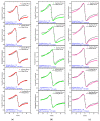Excitation Wavelength and Colloids Concentration-Dependent Nonlinear Optical Properties of Silver Nanoparticles Synthesized by Laser Ablation
- PMID: 36295412
- PMCID: PMC9610074
- DOI: 10.3390/ma15207348
Excitation Wavelength and Colloids Concentration-Dependent Nonlinear Optical Properties of Silver Nanoparticles Synthesized by Laser Ablation
Abstract
We reported experimental results from investigations that employed the Z-scan method to explore the dependence of silver nanoparticles' (AgNPs) nonlinear optical properties on the excitation wavelength, AgNP concentration, and size. Using a 532 nm Nd: YAG laser beam at 100 mJ/pulse for different ablation times, AgNPs were synthesized from a silver target immersed in distilled water. UV-Vis spectroscopy and an atomic absorption spectrometer are used to characterize the optical properties of laser-synthesized AgNPs as well as their concentrations. The AgNPs' size and shape are determined using a transmission electron microscope (TEM). The laser-synthesized AgNPs are spherical, with an average particle size of 12 to 13.2 nm. Whatever the ablation time, the AgNP colloids exhibit reversed saturable absorption and a negative nonlinear refractive index (n2). Both n2 and the nonlinear absorption coefficient (α3) increase as the AgNP concentration increases. As the excitation wavelength and average size of the AgNPs increase, n2 and α3 decrease.
Keywords: Z-scan; laser ablation; nonlinear optical properties; silver nanoparticle.
Conflict of interest statement
The authors declare no conflict of interest.
Figures














Similar articles
-
Nonlinear Optical Properties of Zinc Oxide Nanoparticle Colloids Prepared by Pulsed Laser Ablation in Distilled Water.Nanomaterials (Basel). 2022 Nov 28;12(23):4220. doi: 10.3390/nano12234220. Nanomaterials (Basel). 2022. PMID: 36500847 Free PMC article.
-
Using Femtosecond Laser Pulses to Explore the Nonlinear Optical Properties of Au NP Colloids That Were Synthesized by Laser Ablation.Nanomaterials (Basel). 2022 Aug 28;12(17):2980. doi: 10.3390/nano12172980. Nanomaterials (Basel). 2022. PMID: 36080017 Free PMC article.
-
Using Femtosecond Laser Pulses to Explore the Nonlinear Optical Properties of Ag/Au Alloy Nanoparticles Synthesized by Pulsed Laser Ablation in a Liquid.Nanomaterials (Basel). 2024 Jul 31;14(15):1290. doi: 10.3390/nano14151290. Nanomaterials (Basel). 2024. PMID: 39120395 Free PMC article.
-
Using Femtosecond Laser Light to Investigate the Concentration- and Size-Dependent Nonlinear Optical Properties of Laser-Ablated CuO Quantum Dots.Nanomaterials (Basel). 2024 Oct 18;14(20):1674. doi: 10.3390/nano14201674. Nanomaterials (Basel). 2024. PMID: 39453010 Free PMC article.
-
The Pros and Cons of the Use of Laser Ablation Synthesis for the Production of Silver Nano-Antimicrobials.Antibiotics (Basel). 2018 Jul 28;7(3):67. doi: 10.3390/antibiotics7030067. Antibiotics (Basel). 2018. PMID: 30060553 Free PMC article. Review.
Cited by
-
Experimental Investigation of the Optical Nonlinearity of Laser-Ablated Titanium Dioxide Nanoparticles Using Femtosecond Laser Light Pulses.Nanomaterials (Basel). 2024 Dec 3;14(23):1940. doi: 10.3390/nano14231940. Nanomaterials (Basel). 2024. PMID: 39683328 Free PMC article.
-
Green Synthesis and Characterization of Silver Nanoparticles Using Rice (Oryza sativa) and Spent Coffee (Coffea robusta) Grounds from Agricultural Waste§.Food Technol Biotechnol. 2025 Jun;63(2):159-167. doi: 10.17113/ftb.63.02.25.8925. Food Technol Biotechnol. 2025. PMID: 40735150 Free PMC article.
References
-
- Terashima K., Tamura S., Kim S.-H., Yoko T. Structure and Nonlinear Optical Properties of Lanthanide Borate Glasses. J. Am. Ceram. Soc. 1997;80:2903–2909. doi: 10.1111/j.1151-2916.1997.tb03210.x. - DOI
-
- Boyd R., Masters B. Nonlinear Optics. 3rd ed. Academic; New York, NY, USA: 2008.
-
- Shen Y.-R. The Principles of Nonlinear Optics. 3rd ed. Wiley-Interscience; Hoboken, NJ, USA: 2002.
-
- Agrawal G.P. Nonlinear Fiber Optics. 4th ed. Academic Press; Cambridge, MA, USA: 2006.
-
- Elim H.I., Yang J., Lee J.Y., Mi J., Ji W. Observation of saturable and reverse-saturable absorption at longitudinal surface plasmon resonance in gold nanorods. Appl. Phys. Lett. 2006;88:083107. doi: 10.1063/1.2177366. - DOI
LinkOut - more resources
Full Text Sources
Research Materials

